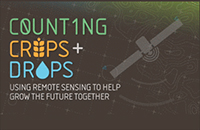

FAO: WaPOR – Satellite and remote sensing for agricultural water management
September 2020. The Food and Agriculture Organization (FAO) has been launching WaPOR, a programme and portal to monitor Water Productivity through Open-access of Remotely sensed derived data. It assists countries in monitoring water productivity, identifying water productivity gaps, proposing solutions to reduce these gaps and contributing to a sustainable increase of agricultural production over Africa and the Near East.
WaPOR provides open access to the water productivity database and its thousands of underlying map layers. It allows for direct data queries, time series analyses, area statistics and data download of key variables associated to water and land productivity assessments. The portal’s services are directly accessible through dedicated FAO WaPOR APIs.
Water and land productivity is assessed in a different way for the three spatial levels:
- On level I (continental level - 250 m ground resolution), water productivity is monitored in terms of biomass production per hectare per cubic meter of water consumed. A distinction is made between irrigated and rainfed agriculture. Land and water productivity are calculated on pixel basis, which can be aggregated to country or river basin level.
- On level II (national and sub-national level - 100 m ground resolution), land and water productivity is monitored for a selected set of countries and river basins while distinguishing several main crops under irrigated or rainfed agriculture. Land productivity is expressed in terms of yield (kg/ha), water productivity is calculated as production per volume of water (kg/m³). Water used for agricultural production is expressed in actual evapotranspiration, where a distinction is made between evapotranspiration originating from precipitation (‘green’ water) and incremental evaporation originating from irrigation (‘blue’ water).
- On level III (irrigation scheme and sub-basin - 30 m ground resolution), land and water productivity is monitored for a selected set of irrigation schemes to assess the functioning of the irrigation system and to propose improvements of these systems. On this level land and water productivity is calculated similarly to level II. In addition, economic water productivity for multiple uses of water is assessed in terms of economic return per amount of irrigation water used. Indeed, water productivity plays a central role in the performance assessment of irrigation which is the basis of irrigation modernization. After modernization of an irrigation scheme, the water services provided to all water users should be more reliable, more cost effective, more adapted to increased climatic variability due to climate change and more environmentally friendly.
FAO’s WaPOR is based on Evapotranspiration projects of Copernicus Sentinel-2 and Sentinel-3 satellite missions by ESA, the European Space Agency. ESA is working with FAO to develop tools for the full use of the Copernicus Sentinels in responding to FAO’s information needs at national to global scales.
Evapotranspiration is the process where water is transferred from the land to the atmosphere by evaporation from soil and other surfaces and by transpiration from plants. Values of evapotranspiration can also be used to monitor the amount of water used in irrigation to make sure that water consumption remains sustainable.
Reference/s
United Nations (2020): Water and Climate Change. New York, March 21.
Source: Food and Agriculture Organization; European Space Agency
Disclaimer: You agree that B2Bioworld is not responsible and will not be held liable for any third party content on its sites or any third-party content, products or services available on other web sites accessed through links from B2Bioworld sites. Links to third-party sites are for your convenience only, and their inclusion on B2Bioworld\'s sites does not imply any endorsement, guarantee, warranty or representation by B2Bioworld.
Other articles recommended
B2Bioworld offers you background information
The Tractor As Smartphone
Safety and responsibility in designing, manufacturing, and operating autonomous agromachines
Big Data & Research – Acquisition, Analytics, and Exploitation
Review: Minute, Tough, and Copious
Science can be fun to read, but be aware. Book Review - open access